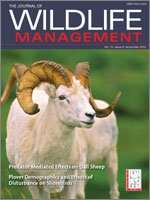Spatial and temporal closures of anthropogenic activities are a common management strategy to increase waterfowl usage of an area. However, empirical evidence, specifically how individual waterfowl respond to disturbance, is lacking to support their efficacy. We exposed radiomarked mallards (Anas platyrhynchos) to walk-in, shooting, or no disturbance along the South Platte River corridor in Colorado, USA, from September to February during 2006–2007 and 2007–2008. Mallards exposed to shooting disturbance had greater mean flight distance after disturbance (FDAD) during September–November (4.58 km, 95% CI = 3.55–5.62) than December–February (3.04 km, 95% CI = 2.51–3.58) and were 35% and 17% greater than mean FDAD of mallards exposed to walk-in disturbance, respectively. Walk-in and shooting disturbance had a similar effect on return rates, and disturbed mallards had higher (0.09–0.41) movement probabilities away from and lower (0.15–0.20) probabilities of returning to treatment locations than controls. Probability of presence of disturbed mallards was 37% lower than controls during the daytime but was equal at night. Mallards exposed to walk-in (0.38 [95% CI = 0.30–0.46]) and shooting (0.23 [95% CI = 0.17–0.30] disturbance had low return rates the first afternoon after a disturbance compared to controls (0.71 [95% CI = 0.65–0.77]). A high proportion of mallards exposed to walk-in (0.75 [95% CI = 0.67–0.83]) and shooting (0.70 [95% CI = 0.64–0.76]) disturbance returned to treatment locations in ≤1 day. Managers may be able to more effectively manage disturbance regimes by 1) accounting for surrounding lands within <10 km, especially lands within <5 km, 2) being conscientious when establishing regulations that will affect levels of disturbance 1–2 days after a previous disturbance, and 3) considering shooting and walking disturbance equally for refuge design.
How to translate text using browser tools
1 November 2010
Mallard Response to Experimental Walk-In and Shooting Disturbance
Joshua L. Dooley,
Todd A. Sanders,
Paul F. Doherty
ACCESS THE FULL ARTICLE
It is not available for individual sale.
This article is only available to subscribers.
It is not available for individual sale.
It is not available for individual sale.

Journal of Wildlife Management
Vol. 74 • No. 8
November 2010
Vol. 74 • No. 8
November 2010
Anas platyrhynchos
closure
Colorado
disturbance
hunting
mallard
radiotelemetry




